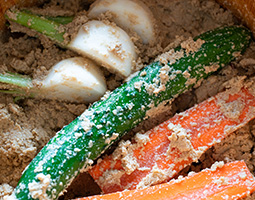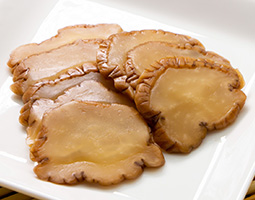INDEX
- English
- 日本語

Natto with miso soup and rice
- English
- 日本語

Soybeans (left) are fermented with salt and rice koji (right) to make miso paste (center)

A variety of tsukemono in a tsukedoko pickling bed 
Slices of the smoked fermented daikon radish known as iburigakko
May 2020
The Fermented Foods of Tohoku

Tohoku is home to many food products made from locally harvested ingredients that have been fermented. Initially produced out of necessity in response to the challenges of its harsh winter climate, the fermented foods of Tohoku have become an essential part of the region’s dietary culture.
All over the world, there are many foods made by fermenting ingredients through the natural processes of microorganisms. In Europe, for example, there are the fermented milk products of Greece, Italy and France; in Asia, there are the fermented grain spirits of China and fish sauces of Vietnam and Thailand. In Japan too, many types of fermented foods and drinks have been produced, including miso, soy sauce, sake, natto (soy beans), rice vinegar, tsukemono (pickles) and katsuobushi (dried bonito).

Koizumi Takeo, the Fukushima-born son of a sake brewer and emeritus professor at Tokyo University of Agriculture, has researched fermented foods from around the world. According to Professor Koizumi, “No other country has as many types of fermented foods as Japan. This is because Japan is humid and the conditions are well suited to reproducing the microorganisms that ferment food materials. Since Japan also has abundant food materials such as fish, vegetables and grains, there are naturally more types of fermented food.”
One of the main advantages to fermenting foods is that such foods can be stored for long periods of time. In the days before refrigerators, fermentation was necessary to preserve food. The Japanese eat a great deal of fish, so there are numerous fermented foods using fish. Well-known examples are shiokara, made of cut, salted and fermented squid and its intestines; and narezushi, made of fish pickled and fermented together with rice. The Tohoku region in northeast Japan has a particularly wide variety of fermented food. According to Professor Koizumi, one reason is its harsh winter climate. Since people could not harvest farmed products in the winter because of the cold and snow, they made fermented foods that could be preserved to eat during the winter months. The people of Tohoku produce a wide variety of tsukemono (pickles), for example. They have historically pickled vegetables such as daikon radish, cucumber, Chinese cabbage and eggplant in a tsukedoko (bed) of miso, soy sauce and koji (rice malt). Vegetable tsukemono contain abundant vitamins made by microorganisms, are rich in dietary fiber and extremely healthy.

“Tohoku was traditionally an agricultural region,” explains Professor Koizumi. “People sweat from farm work in the summer and lose salt. Tsukemono contain a great deal of salt that replenishes people’s supply. The people of Tohoku needed fermented food in order to survive.”
The people of Tohoku eat a lot of natto, which is made by fermenting soybeans. According to the Family Income and Expenditure Survey by the Statistics Bureau of the Ministry of Internal Affairs and Communications, the highest expenditure on natto among all major cities in Japan (average from 2017 to 2019) was in Fukushima in Fukushima Prefecture, followed by Morioka in Iwate Prefecture, with fourth place taken by Yamagata in Yamagata Prefecture – all in Tohoku. According to Professor Koizumi, today, the people of Tohoku commonly eat natto on rice as do people in other areas, but during and before the Meiji period (1868–1912), they ate it in their miso soup. Since the Nara period (710–794), the Tohoku farmers grew rice in the fields and soybeans on the ridges between them. Soybeans are the main ingredient of tofu and miso. The people of Tohoku put tofu in their miso soup together with natto.
“Prior to the Meiji period when Japan modernized, the Japanese people, including those of Tohoku, ate scarcely any meat, but soybeans have as much protein as meat. People were thus able to obtain plenty of protein from miso soup, natto and tofu without having to eat meat, which is why the people of Tohoku were able to build stamina to get through the cold winter,” says Professor Koizumi.

Of the many kinds of fermented foods in Tohoku, Professor Koizumi highly recommends that inbound visitors to Japan try iburigakko from Akita Prefecture. Iburigakko is daikon pickled in nukazuke (salted rice bran) and smoked with wood. There are many food products around the world that are smoked, such as coffee, whisky and ham, but iburigakko is the world’s only smoked fermented pickle.
“Many fermented food products have a unique smell and taste and may not suit the palates of people overseas who are not used to them,” says Professor Koizumi. “But iburigakko has a familiar wood smoke smell and I believe people of other nationalities would have no problem eating it.”
The combination of climate, agricultural produce and fermentation have led to the creation of countless distinctive, delicious and nutritious foods in northeast Japan.
(This is a revised version of the article that appeared in the February 2013 issue of Highlighting Japan.)

